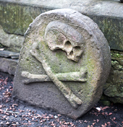The Black Death Revealed

Underneath the heart of London's financial district lie the remnants of the East Smithfield Cemetery. There lie some 24-hundred bodies, each carefully laid with layers of charcoal in between. Around many bodies are trinkets revealing the lives they once lived. They are victims of the Bubonic Plague, or Black Death, as it's also known, and within five years, the disease wiped out between one-third to one-half of not only London's population but Europe's as well.
Now East Smithfield has provided scientists with crucial material which confirmed the bacterium, Yersinia pestis, was responsible for the Black Death by allowing them to sequence the microbe's genome. This settles an old debate among scientists. Doubts about whether the plague caused the 14th century pandemic persisted because today's plague infects and kills far fewer numbers.
Determining the full genetic sequence of the old strain could explain what made it so virulent. Researchers focused on samples of dental pulp, the innermost layer of tissue in teeth from the East Smithfield bodies. They were able to extract, purify and enrich for the Yersinia genetic information using a technique called targeted capture.
A lab-synthesized ‘bait' DNA snagged ancient Yersinia DNA strands, leaving soil-microbe DNA and other material behind. Then using DNA sequencers, they read snippets of the nearly seven hundred year old microbe.
Turns out, the old strain is remarkably similar to today's plague, which led researchers to hypothesize that climate, age distribution and living conditions of 14th century London and Europe contributed to the pandemic. Downtown London in 1348 was densely packed and filthy; the climate was wet and cold; and food was in short supply. People also didn't have access to antibiotics.
Understanding how the microbe behaved then can help people prepare for future outbreaks of this and other microbes. Yersinia strains sicken about three thousand people around the world every year. With antibiotics, however, 85% recover, reinforcing the power of modern medical capabilities.
More Information
Hunting for a Mass Killer in Medieval Graveyards
The New York Times reports on the ongoing attempts to sequence
the microbe that causes Bubonic Plague.
The lost plague - London graveyards suggest that Black Death strain may be extinct
Discover Magazine article regarding the ancient strain of Yersinia pestis, the microbe responsible for the Black Death.
A draft genome of Yersinia pestis from victims of the Black Death
2011 research article on these recent
studies, published in the esteemed scientific journal Nature.